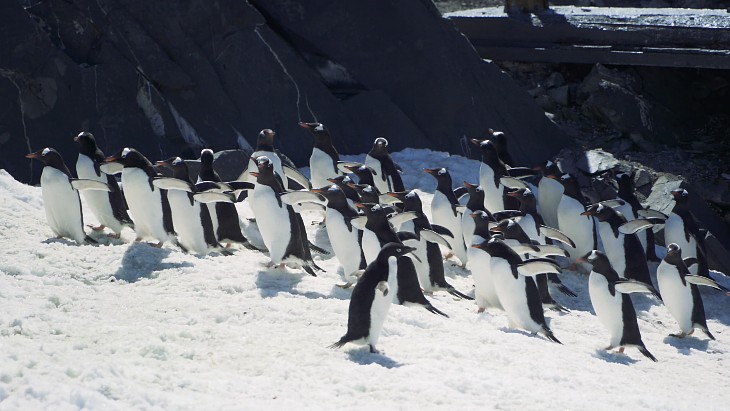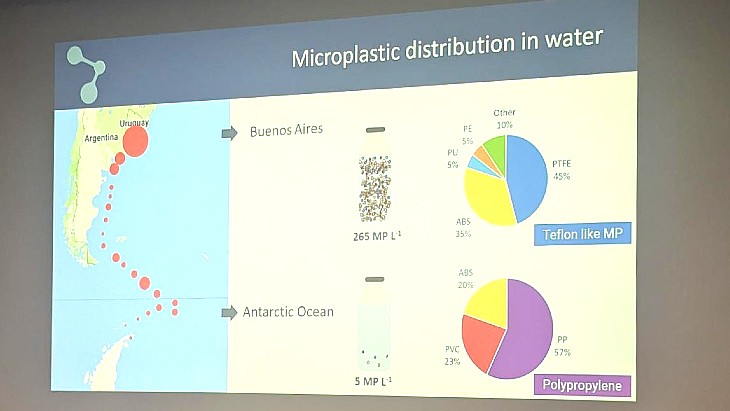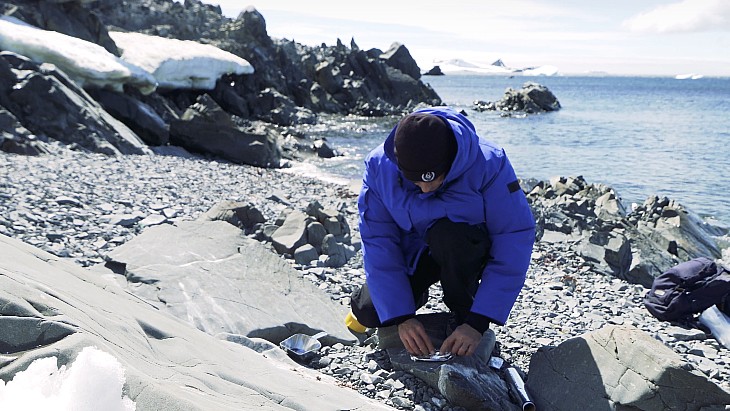UPDATE
Scale of microplastics in Antarctic revealed in preliminary survey results
The first results of the pioneering scientific research project launched earlier this year have catalogued microplastic particles in the sea water, sediment and animals in Antarctica.

The preliminary results were outlined during an International Atomic Energy Agency (IAEA) General Conference session focusing on the study, which is supported by Argentina and forms part of the wider IAEA NUTEC plastics initiative, which aims to use nuclear technologies to tackle plastic pollution.
Nathalie Bernard, from the IAEA Marine Environment Laboratories and University of Buenos Aires, unveiling the results, said that "sadly we have found microplastics everywhere, on every sample, every matrix". She said that the concentrations of microplastics varied by location and by day.
More than 250 samples were collected from the Almirante Irizer icebreaker, which sailed 27,209 kilometres over 125 days covering 84 sampling stations. Over the course of a week 166 samples were collected from Argentina's Carlini research station base as part of what was described as the first study of microplastics pollution from South America to Antarctica.
The samples were of water, of sediment and also of penguin droppings and shellfish. Bernard said: "All of these results were possible thanks to nuclear techniques, specifically vibrational microspectroscopy which allows us not only to count, but also identify polymers. We were able to analyse particles as small as 20 microns (WNN note: for comparison a human hair is about 100 microns) and this is important because we found out that almost 90% of the particles we analysed were smaller than 100 microns and ... most of the studies conducted before have focused on larger particles, larger than 300 microns, which clearly overlooks the larger majority."
The preliminary results - with 30% of the samples analysed so far, found that in terms of distribution in water, in Buenos Aires it was 256 microplastic particles per litre, compared with 5 microplastics particles per litre in the Antarctic Ocean and 21 microplastics particles per litre at Carlini Station in the Antarctic.
The Carlini samples found 6000-15,000 microplastic particles per kilogramme of sediment, 15 microplastic particles per square metre of sand and 200-4000 microplastic particles per biological sample of shellfish or penguin droppings.

The prevalence and type of microplastics was shown to the session (Image: WNN photo/IAEA/Bernard slide)
There were 11 different types of plastics found in the samples, 62% were "Teflon-like microplastics" and 29% were polyethylene-like. Examples of the types of products using the types of plastics found included frying pans, PVC pipes and plastic drinks bottles.
The early theories about the possible sources of the pollution in Antarctica include fisheries, local human activities and global sources, via the atmosphere or ocean currents.
Bernard said that the conclusions of the preliminary study was that "we know now that microplastics are everywhere, that we can find different levels and types between the sites and that the levels in Antarctica are relatively low if we compare them with highly populated industrial zones - but they are far away from zero, which is what it was thought to be until recently in Antarctica.".
The next steps are to finalise the analysis and do extra checks before sharing the results globally and using the figures as a baseline for future surveys, to assess possible pollution sources and inform policy makers for local and global actions in line with the Antarctic Treaty.
The meeting also heard progress reports on the United Nations actions to end plastics pollution and how the NUTEC initiative can help with plastics upcycling using irradiation to allow plastic waste to not just be traditionally recycled, but also used in cement or in wood/plastic composits - one of the examples given was Argentina using radiation-modified railway sleepers from plastic waste.
Argentina's Foreign Affairs Minister Diana Mondino said that the country was one of the original signatories of the Antarctic Treaty and said: "There's growing concern in understanding the impact in the Antarctic ecosystem from plastics and microplastics." She said the results had prompted the creation of a regional group in Latin America led by Argentina to focus on the issue.
IAEA Director General Rafael Mariano Grossi said the NUTEC initiative had been well received because "we do have a serious problem with microplastics, nanoplastics and we did also have a scarcity of information, objective information". He said having the facts was important so people can take "informed decisions when it comes to the protection of this environment, which is so pristine and that we all care for".
"This is not a simple environmental endeavour that we take for the sake of knowing a little bit more - the idea is that we provide important information that is relevant for fisheries, relevant for very important economic activities in all our countries."
Australia's ambassador Ian Biggs said that Australia had a major stake in the international effort in Antarctica and he said that according to projections there could soon be a tonne of plastic in the ocean for every three tonnes of fish, saying this showed the necessity of action to tackle plastic pollution and he said Australia believed that the NUTEC programme was "making a real difference in helping countries address pressing global challenges on plastic pollution".

More than 400 samples were taken during the study (Image: Still from IAEA video)
The background
The IAEA's NUTEC plastics scheme was established in 2020 and uses a series of monitoring laboratories to use nuclear technology to sample and analyse microplastics - which are bits of plastic less than 5 millimetres in diameter - in the environment. There are more than 60 countries participating in monitoring of microplastics in the sea, and the goal is to equip more than 50 laboratories with the technology to form a global monitoring network.
The aim is to then be able to take action to bring in measures designed to reduce the sources of the pollution - at least 30 countries are involved in developing innovative recycling technology, including using irradiation to treat plastics and make them fit for reuse, or for a wider range of reuses. This process uses gamma and electron beam radiation technologies to modify certain types of plastic waste, breaking down plastic polymers judged not to be of sufficient quality into smaller components and then allowing them to be used to generate new plastic products.
The IAEA cites studies suggesting that only around 10% of plastic produced between 1950 and 2015 has been recycled, with the majority (about 60%) going to landfill, meaning action is imperative given estimates that there will be one tonne of plastic for every three tonnes of fish within a few years.
Grossi visited an IAEA mission in Antarctica in January with Argentina's president to see the start of work for the project, with the IAEA explaining that "there is still almost no information available on where and how much microplastics arrive in the Antarctic and how much is taken up by Antarctic organisms. There is also very little data existing on the types of microplastics reaching this pristine area through ocean currents, atmospheric deposition and the presence of humans in the Antarctic".
It also said the "presence of microplastics can contribute to accelerating the ice-loss in Antarctica by reducing ice reflectivity, altering surface roughness, promoting microbial activity, acting as thermal insulators, and contributing to mechanical weakening of the ice structure".
Antarctica’s Deep Vulnerability Exposed at 11th Scientific Conference

Image by James Rathmell.
The 11th Scientific Committee on Antarctic Research conference was held in Pucón, Chile August 19-23, 2024. Fifteen-hundred academics, researchers, and scientists specializing in Antarctica met to share cutting-edge research. Reports at the conference exposed new dimensions of the Antarctic risk profile that should move the world’s leadership posthaste to mitigate society’s self-destructive dependence on fossil fuels.
Antarctica is starting to carry the brunt of too much CO2 leading to too much heat, leading to unstable ice sheets. And it’s happening much, much faster than anybody thought possible. This is a relatively new development that could have far-reaching consequences.
For example, Gino Casassa, glaciologist, head of Chilean Antarctica Institute commented: “Current estimates show sea levels rising by 4 meters (13 feet) by 2100 and more if emissions continue to grow.” (Source: Scientists in Chile Question if Antarctica Has Hit a Point of No Return, Reuters, August 28, 2024)
Thirteen feet higher won’t suddenly appear in 2100. It builds up over decades. Assuming emissions “continue to grow”, as warned by Dr. Casassa, you’ve gotta wonder, with 13 feet by 2100, what will 2035, or 2050, look like? That’s right around the corner.
Sea level rise is one of the most challenging fields in science and thus produces the most complex results. For example, in comparison to Casassa’s estimate of 13 feet by 2100, a recent study: What Are the Best – and Worst – Case Scenarios for Sea Level Rise? MIT Climate Portal, June 12, 2024: “By 2100, we could see as little as 8 inches of additional sea level rise, or over 6 feet—based partly on how much we continue to pollute the climate, and partly on how the oceans respond to climate change that’s already baked in… despite the enormous stakes for the future of humanity, it remains frustratingly difficult to know how much sea level rise is in store for us. All we know for sure is that taking strong and immediate action to control our greenhouse gas emissions gives us the best chance to avoid meters of sea level rise. ‘The difference between the low-end projections and the high-end projections is many trillions of dollars in infrastructure, and hundreds of millions of people losing their homes,’ Minchew says (Brent Minchew, MIT geophysicist) ‘But we don’t have a good answer to which one of those scenarios is more likely.”
The biggest concern echoed throughout the conference hall: “Antarctica is changing faster than expected.” For example: “Extreme weather events in the ice-covered continent were no longer hypothetical presentations, but first-hand accounts from researchers about heavy rainfall, intense heat waves and sudden Foehn (strong dry winds) events at research stations that led to mass melting, giant glacier breakoffs and dangerous weather conditions with global implications,” Ibid.
A hot topic was whether Antarctica has reached a tipping point, a point of accelerated, irreversible sea ice loss, especially West Antarctica where the Thwaites Doomsday Glacier is located. But scientists have yet to determine whether current observations indicate a ‘temporary blip” or a “downward plunge of sea ice.” Nevertheless, by all appearances, it’s advanced far enough for “plunging sea ice” to raise very serious concerns.
What is clear is the rate of change, unprecedented, nothing compares. According to Liz Keller, a paleoclimate specialist at Victoria University of Wellington/New Zealand; ‘”You might see the same rise in CO2 over thousands of years, and now it’s happened in 100 years,” Ibid. Which is a prime example of today’s human-generated climate change working >10 times faster than nature on its own.
That one factor is what confuses those who argue “oh yeah, the climate always changes, so what?” However, there’s regular climate change in nature, like they allude to, which takes centuries to develop and then, there’s turbo-charged climate change, like we’ve got now that takes decades, not centuries, thanks to human-generated excessive CO2 thrusts from burning fossil fuels.
Climate change has become a straight-forward function of human activity.
Hopefulness
According to some reports at the conference, “the worst-case scenarios can be avoided by dramatically reducing fossil fuel emissions.” Specifically, regarding mitigation, Mike Weber, a paleoceanographer, University of Bonn, who specializes in Antarctic ice sheet stability: “If we keep emissions low, we can stop this eventually. If we keep them high, we have a runaway situation and we cannot do anything.”
On the other hand, there is evidence that ecosystems may already be exceeding boundaries, e.g., Mathieu Casado, a paleoclimate and polar meteorologist at France’s Climate and Environment Sciences Laboratory claims dozens of ice core collected throughout the ice sheet have allowed him to reconstruct temperature patterns in Antarctica dating back 800,000 years. The last time the planet was as warm as today, 125,000 years ago, sea levels were 6-to-9 meters (20-to-30 feet) higher with a large contribution coming from West Antarctica. Ipso facto, with temperatures today as warm as 125,000 years ago causing seas to be 20-30 feet higher, then every coastal megacity should be/will be flooded, which begs the obvious question of “how long do these things take to playout?” And, more importantly, how do we get CO2 and temperatures back down?
Speakers at the conference made special note of the extraordinary speed and amount of carbon -CO2- being pumped into the atmosphere, unprecedented, causing rapid global warming. There’s no previous paleoclimate record of CO2 hitting the planet with such ferocity and large scale and so suddenly. This recalls Michael Mann’s Hockey Stick that famously said it all with one vertical image.
The hockey stick graph is a visualization of the average temperature of the Northern Hemisphere over the past 500 to 2000 years. Because of the spectacular hockey stick concept, Professor Mann became an overnight target of right-wing charlatans and fossil fuel attempts to destroy him. They failed: A Jury in February 2024 awarded Mann more than US$1 million in a lawsuit that accused two conservative commentators of defamation for challenging his research and comparing him to a convicted child molester.
“The Hockey Stick achieved prominence in a 2001 UN report on climate change and quickly became a central icon in the ‘climate wars.’ The real issue has never been the graph’s data but rather its implied threat to those who oppose governmental regulation and other restraints to protect the environment and planet.” (Foreword by Bill Nye, The Hockey Stick and The Climate Wars by Michael E. Mann)
In that regard, with parts of West Antarctica hanging by a very big thread, timing couldn’t be worse as the climate wars heat up once again: Bloomberg News headline: Right-Wing Populist Backlash Is Threatening Climate Fight d/d June 20, 2024: “The green revolution is in trouble. The rise of the nationalist right in much of the Western world has placed huge question marks over commitments to transition out of fossil fuels to fight climate change. Donald Trump in the US and other populist politicians have vowed to jettison low-carbon policies and downplayed the impact of global warming.”
Antarctica has rapidly become a dangerous climate change symbol of major concern and nail-biting as it serves to verify Mann’s early warnings. Global warming has become humanity’s number one challenge for survival of the species. Mann’s Hockey Stick is an amazing analog of 8 billion people sucking up oil from the planet, belching out CO2 in hockey stick fashion, vertically, up, up, and away into an increasingly overloaded CO2 atmosphere that weighs on planetary heat.
Reality
Meanwhile, as stated numerous times in articles like this one, the oil and gas industry has publicly brushed aside concerns about climate change. Looking ahead to the future, it’s full bore, full speed ahead with record-setting fossil fuel production and record-setting CO2 on a very full agenda of oil and gas production to 2030 and beyond.
“The world’s fossil-fuel producers are on track to nearly quadruple the amount of extracted oil and gas from newly approved projects by the end of this decade, with the US leading the way in a surge of activity that threatens to blow apart agreed climate goals.” (The Guardian, March 28, 2024). Questioning whether West Antarctica, especially the Doomsday Glacier, can survive the onslaught of fossil fuel interests looking the other way as right-wing interests threaten anything and everything green.
According to Mike Weber, paleoceanographer, University of Bonn, who specializes in Antarctic ice sheet stability, regarding fossil fuel CO2 emissions: “If we keep them high, we have a runaway situation, and we cannot do anything.”
We’re keeping ’em high.
No comments:
Post a Comment